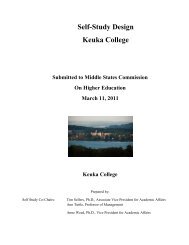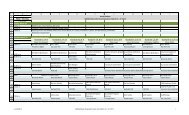final version of the self-study document - Keuka College's Middle ...
final version of the self-study document - Keuka College's Middle ...
final version of the self-study document - Keuka College's Middle ...
You also want an ePaper? Increase the reach of your titles
YUMPU automatically turns print PDFs into web optimized ePapers that Google loves.
(WODE) serving as <strong>the</strong> foundation for this initiative. To date, 42 accelerated online courses have<br />
been developed since its inception in July 2008, largely to meet <strong>the</strong> needs <strong>of</strong> students in <strong>the</strong><br />
ASAP program, but since summer 2011, a small number <strong>of</strong> general education courses have been<br />
<strong>of</strong>fered online to traditional home campus students. In addition, <strong>the</strong> Wertman Office <strong>of</strong> Distance<br />
Education supports <strong>the</strong> overall Accelerated Studies for Adults programming through its staff who<br />
provide instructional design, instructional resources, and student and instructor technical support.<br />
At <strong>the</strong> end <strong>of</strong> its fourth year <strong>of</strong> operation in 2011-2012, WODE generated a gross margin <strong>of</strong><br />
$175,000 for <strong>the</strong> College, and it has streng<strong>the</strong>ned its foundation for fur<strong>the</strong>r growth in both <strong>the</strong><br />
traditional and non-traditional program areas.<br />
While online course <strong>of</strong>ferings have grown as a result <strong>of</strong> this strategic direction, students are not<br />
yet able to complete more than fifty percent <strong>of</strong> any program or certificate <strong>of</strong>fered through <strong>Keuka</strong><br />
College using distance education. <strong>Keuka</strong> expects to continue to build competency and capacity<br />
related to distance education course <strong>of</strong>ferings with <strong>the</strong> goal <strong>of</strong> <strong>of</strong>fering students <strong>the</strong> option <strong>of</strong><br />
completing more than fifty percent <strong>of</strong> programs and certificates online. Currently, <strong>Keuka</strong> has a<br />
proposal for an online M.S. Management under review by New York Education Department. The<br />
revenues from <strong>the</strong>se different facets <strong>of</strong> <strong>the</strong> academic portfolio have allowed <strong>the</strong> College to invest<br />
in program quality through increased faculty lines and enhanced faculty salaries, increased<br />
student support services, improvements to academic and residential facilities, and improved<br />
educational technology.<br />
<strong>Keuka</strong>’s faculty and staff continue to improve <strong>the</strong>ir processes for assessment and use <strong>of</strong><br />
assessment information to improve teaching and learning. Faculty and staff review data from<br />
program entry to program completion, including but not limited to freshman placement, major<br />
curricular outcomes, general education outcomes, and institutional student learning outcomes.<br />
Direct measurement <strong>of</strong> student learning occurs through portfolios, capstone<br />
coursework/presentations, pass-rates on qualifying exams in certain majors, and field experience<br />
evaluations. Along with regular collection, reporting, and monitoring <strong>of</strong> grades, retention, and<br />
placement data, student learning and institutional effectiveness are also indirectly assessed<br />
through student <strong>self</strong>-reported responses on institutional, programmatic, and commercially<br />
prepared surveys (NSSE, Noel-Levitz) and student feedback on course evaluations. As <strong>of</strong><br />
December 2009, all traditional academic programs had concluded a strategic planning exercise,<br />
using a template approved by <strong>the</strong> Strategic Planning Committee and vetted by Division Chairs;<br />
this exercise led not only to proposals for new majors and minors/concentrations, but also to<br />
recommendations, many since implemented, to add or replace necessary equipment to meet<br />
student learning outcomes in <strong>the</strong> natural sciences, to provide introductory workshops focusing on<br />
career preparation within liberal arts programs, and to support undergraduate student research<br />
and creative projects through mini-competitive grants.<br />
In December 2010, per <strong>the</strong> request <strong>of</strong> <strong>the</strong> Vice President <strong>of</strong> Academic Affairs (VPAA), each<br />
undergraduate program completed a formal <strong>self</strong>-<strong>study</strong>, with a focus on assessment <strong>of</strong> student<br />
learning (see Appendix I.4 Proposed Program Review/Self Study Guidelines). Prior to <strong>the</strong><br />
submission <strong>of</strong> <strong>the</strong> program reviews, <strong>the</strong> VPAA and <strong>the</strong> Associate Vice President <strong>of</strong> Academic<br />
Programs (AVPAP) met with each program to review assessment work to date, discuss how<br />
assessment <strong>of</strong> program goals was driving <strong>the</strong>ir program’s improvement, and provide tools and<br />
advice for future assessment needs. The AVPAP, along with <strong>the</strong> ad hoc faculty Graduate<br />
Outcomes Team (GO Team), developed and distributed a “Fundamentals <strong>of</strong> Assessment” tool kit<br />
to ensure each program had <strong>the</strong> same program elements in place. These fundamentals included<br />
clearly articulated program goals; a learning opportunities (curriculum) map showing in what<br />
Page 7 <strong>of</strong> 8 Introduction




